Arrecife (#es8000)
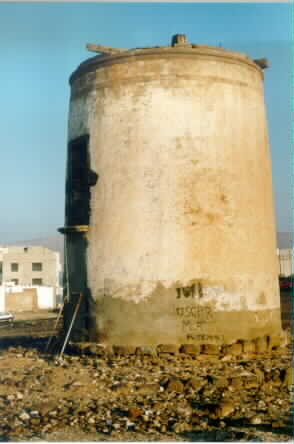
Substantially complete tower remaining, though no ground level access to interior of tower. This mill, on a patch of waste ground within the Island's capital, is beginning to suffer from vandalism.

The island of Lanzarote, one of the Canary Islands, has limited natural sources of energy - it has no running streams and no woodland for example. What it does have however is ample wind, and for centuries the island has used wind power both to grind grain, and to pump water. Recently the use has extended further to include electricity generation.
There are thus a number of distinct types of windmill to be found on the island:
Both the squat tower mills, and the open wooden trestle mills were used for grinding, and although both translate into English as windmill, the Spanish language distinguishes between the solidly built tower mills (molinos), and the open trestle design (molinas, or molinetas).
It's difficult to start talking about Lanzarote without first explaining just a little about the island's most famous and influential son, Cesar Manrique.
Manrique had many roles in life, including those of painter, architect, sculptor, environmentalist and town planner. He was born in 1919, in Arrecife, and after periods living in Madrid and New York, he returned to live in Lanzarote in 1968. His vision for the island was to make it "a paradise for the few who have an eye for the special" - and through his energy and vision, Lanzarote is unique. His influence served to limit development on the island - notably (with a single regretable exception), all buildings are low rise developments, and there is a complete absence of advertising billboards. The island's major tourist attractions were largely "built" by him - though since a particular strength of his was to develop in harmony with what was already there (be it nature or a preexisting structure), then "built" is not always the most appropriate word.
As well as the buildings and attractions he created, examples of his scuptures and other works are seen throughout the island, and in particular at the Foundation that bears his name. His profound influence on the people of Lanzarote lives on, despite his tragic death in a car accident in September 1992.
This page originated as a Survey of remaining windmills - Sept/Oct 1997
The tower mills of Lanzarote are a development of the traditional Spanish windmills, found particularly in La Mancha. However unlike those mills (which are typically just 2 stories high), the mills on Lanzarote have 3 stories, with 2 entrances - one into the middle storey, as well as the expected one into the ground floor.
The mills have a gently inclined windshaft, with 4 fabric covered wooden framed sails.
This type of windmill is a local variant, which came to dominance around the end of the 19th century, and the beginning of the 20th. The base is generally an unremarkable building, just one storey high, surmounted by a wooden trestle tower about 6 metres high. Just the top of the trestle is able to rotate, so that the sails can be made to face the wind, and the power is transmitted down a thin (metal) shaft to the millstones housed in the building at the base.
These mills were able to work in lighter winds than the tower mills, and generally produced finer flour, though the yield was somewhat less.

Substantially complete tower remaining, though no ground level access to interior of tower. This mill, on a patch of waste ground within the Island's capital, is beginning to suffer from vandalism.






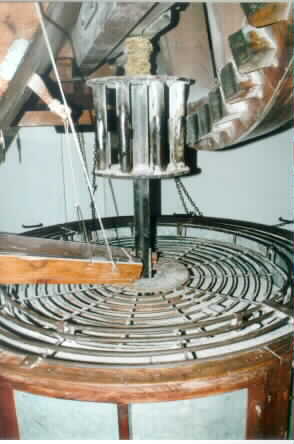
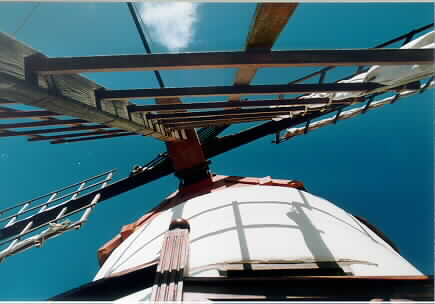
This windmill inside the Jardin de Cactus tourist attraction, is now restored to working order. As well as the working stones in the mill itself, a number of other millstones have been used as features within the cactus garden.
"Beneath the village is a windmill of the regular Don Quixote type, and so low down, that we can readily understand that individual charging it. Near the windmill is an earth quarry, for in this plain of lava, once no doubt a fruitful valley, mould has to be dug from beneath the slag. The quarrying has gone down some 20 feet, leaving here and there monoliths of lava, pillars standing upright, originally on a level with the ground"from Tenerife and its six satellites; or The Canary Islands past and present by Oliva M Stone published by Marcus Ward and Co Ltd, 1887, describing a tour of the island in 1884.
Something over 100 years later, the situation is much the same - the windmill still stands guard over the quarry, and the lava pillars are still there. What has changed however is that whilst the windmill is still capable of grinding "gofio" and "frangollo", the quarry is no longer in use - instead it is home to a collection of 9000 cactus specimens, representing 1400 different species. This "Jardin de Cactus" which opened in March 1990, was Cesar Manrique's last completed project before his death. As was his trademark, the resulting attraction carefully blends what was there already together with Manrique's additions, and has rapidly become a major tourist draw.
The mill can be taken as typical of those built on the island, and has the following characteristics
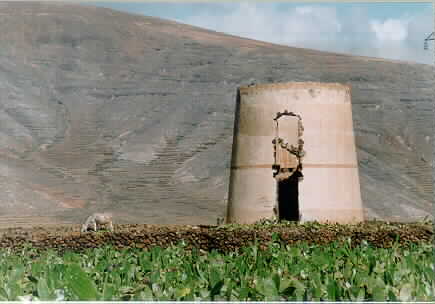
This mill, within sight of the other Guatiza mill at the Jardin de Cactus, is similarly surrounded by fields of fig cactus. It is however in far worse condition, consisting of just the tower shell, without any interior machinery, and with some material damage to the tower.
The surrounding fig cactus plants are grown not for their fruit, but rather because they act as hosts for the parasitic cochineal beetle. It is from the dried lava of this beetle that the natural red dye cochineal is made.
nothing but a few remnants of machinery to show this building (itself in poor shape) was ever a mill
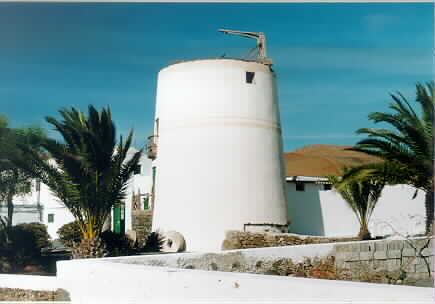
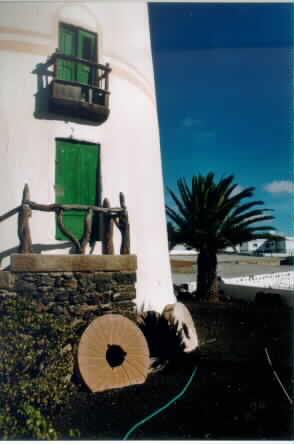
Tower in good condition, attached to working milling business. There are some slight remains of the cap structure to be seen, but interior machinery state not determined. Millstones can be seen in the surrounding landscaped garden.
Info from the City Council added 18/3/01: Constructed 1870 by Balthasar Martin, at the time Secretary of the City Council of San Bartolome. Sold originally to Dr Don Fermin Rodriguez, in 1919 the mill again passed on to Don Jose Maria Gil, and then to his heirs. The milling business alongside still produces gofio.
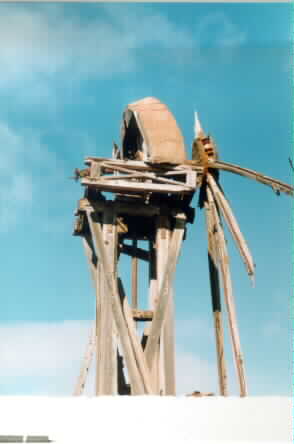
Built 1910, with 12 canvas covered triangular vanes. {Source: City Council of San Bartolome}
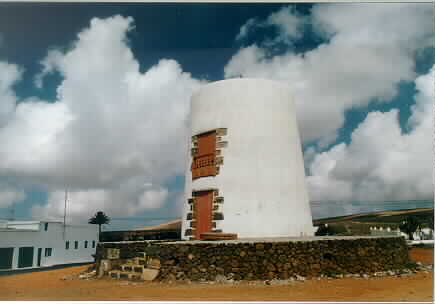
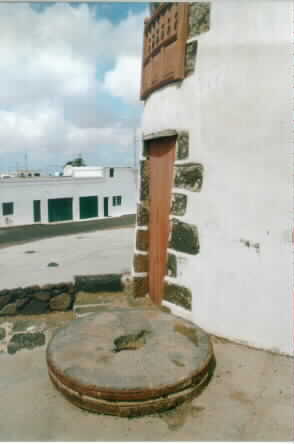
Tower complete and exterior well maintained, in a pleasant square within the town. A millstone has been set as a feature outside the tower.
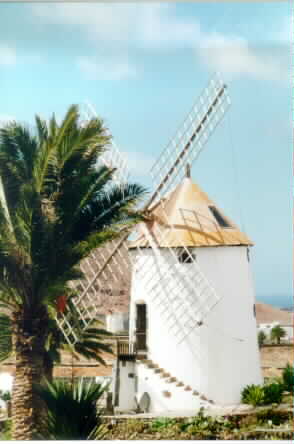
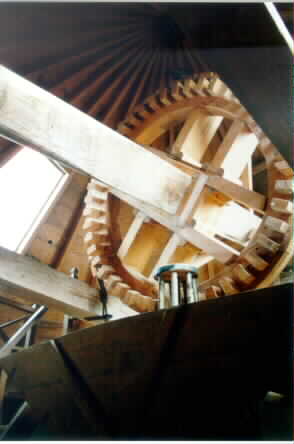
This mill is one of the centre pieces of the recently opened "museum of agricultural and rural tradition". The museum is a fascinating look at traditional life on Lanzarote, and fortunately the philosophy of the owners is such that, in their words "economic returns are not paramount". On the day I visited, the number of staff exactly matched the number of visitors - there were 3 of each of us!
The mill itself appears to have been completely rebuilt internally (not merely restored) - the woodwork is all brand new with no evidence of any original machinery. In addition the tower and cap have a surprising number of windows, almost as if these were designed in order to make it much lighter inside for visitors! I was unable to find out any more about the history of this mill - the staff did not speak English (and I do not speak Spanish); and the laid back commercial nature of the establishment means that there is currently no guide book availible to give such details. However the distinct impression I got was that the village of Tiagua did not really need 4 windmills - this tower mill, 2 trestle mills within the museum complex, and another tower mill across the road, so it's entirely possible that the museum examples were either moved here or are replicas.
[info] [info]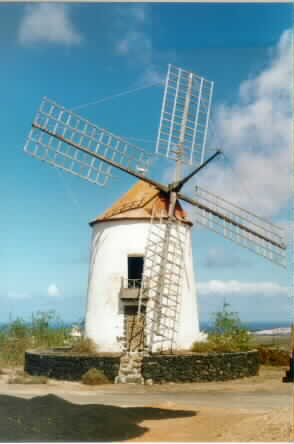
Complete mill, in visibly good condition, with 4 sails (though beginning to show some signs of damage).
This mill is literally just across the road from the mill in the agricultural museum.
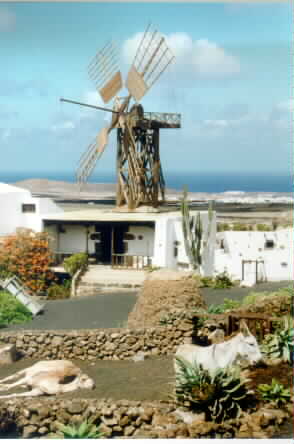
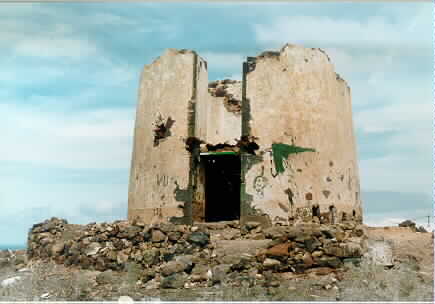

Gardens include the black lava covering for which the area is rightly famous.
External decoration for mini golf course
In addition to true working mills, being such a symbol of the island, there are numerous "fakes" to be found - ie mills built within the past few years for purely decorative purposes. A particular example of this is at the luxury hotel "Los Jameos Playa" in Puerto del Carmen, where there are colourful mills arranged all around the outside of the hotel development. It's interesting to compare the mills actually built (with bright metal sails painted red, blue and yellow), with the architect's model on show inside, which envisaged the mills as having a more traditional appearance, with canvas rigged sails.
Monte Mina5 turbines, of "Vestas" design |
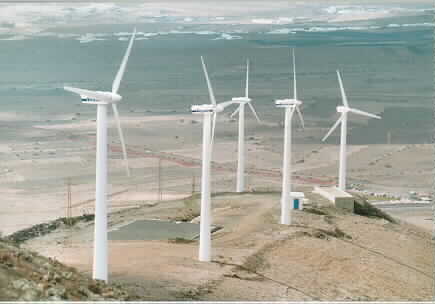
More Photos |
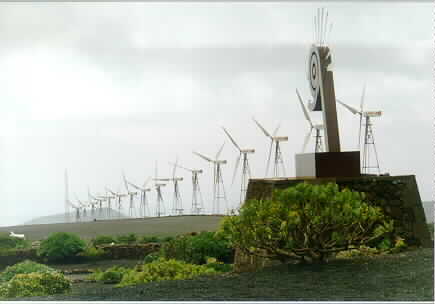
More Photos |
Los Valles - El Parque Eolico48 turbines of various designsThe designer, painter (and long standing friend of Cesar Manrique) Luis Ibanez is responsible for producing both the park logo, and also the actual gardens of the park. |
Small scale generationIn addition to the large scale turbines, numerous houses and villas have small scale devices (generally roof mounted), which serve to supplement the household's electricty needs. (Although aparently getting much better, power outages have been a fact of life on the island for many years). |
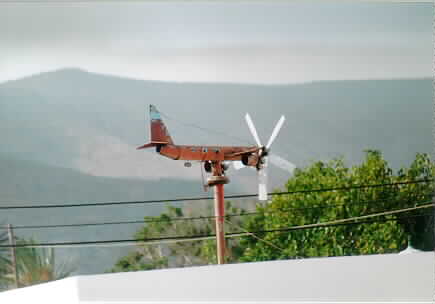
|
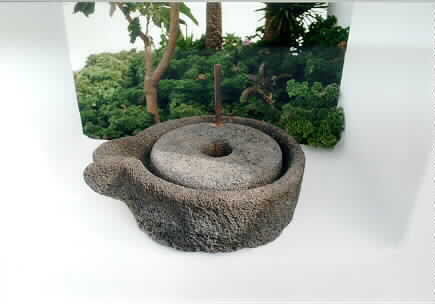
and animal power for rather larger mills
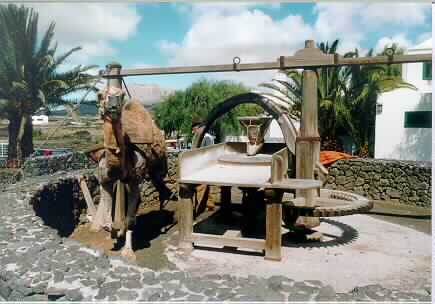
In addition, the following general guide book to Lanzarote is a cut above the rest of the pack
| Last updated 16/09/2025 | Text and images © Mark Berry, 1997-2025 - |